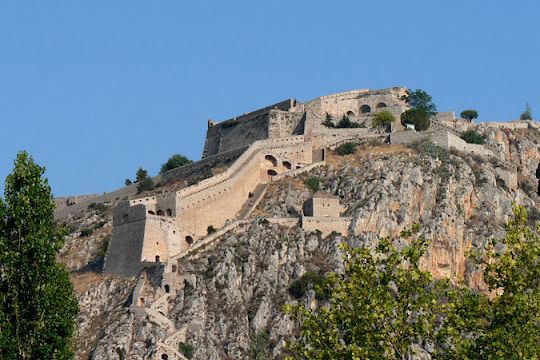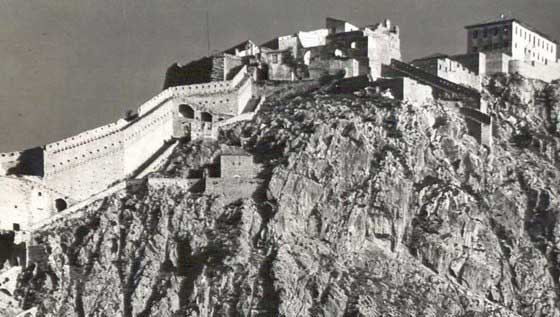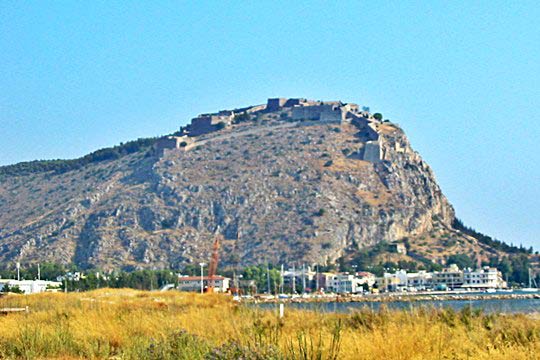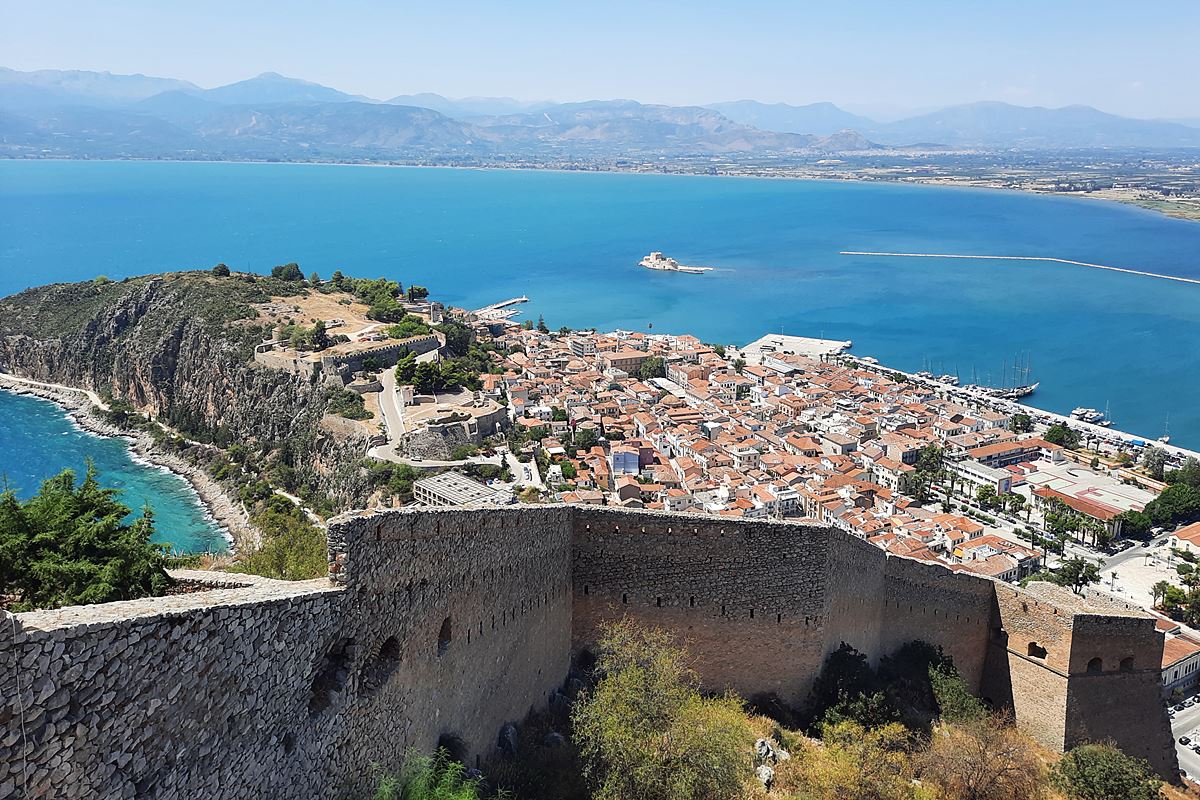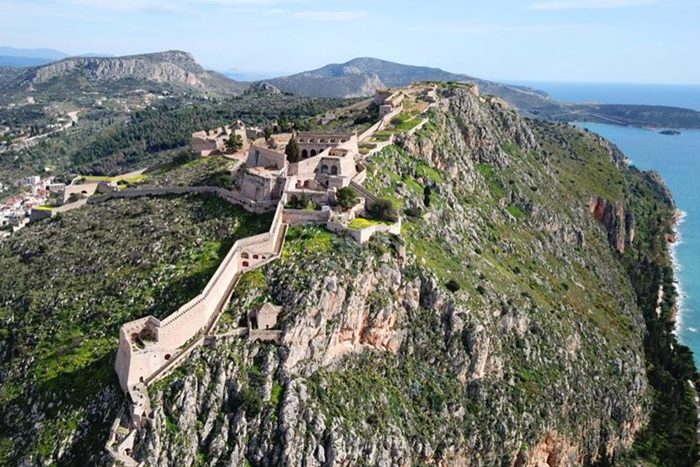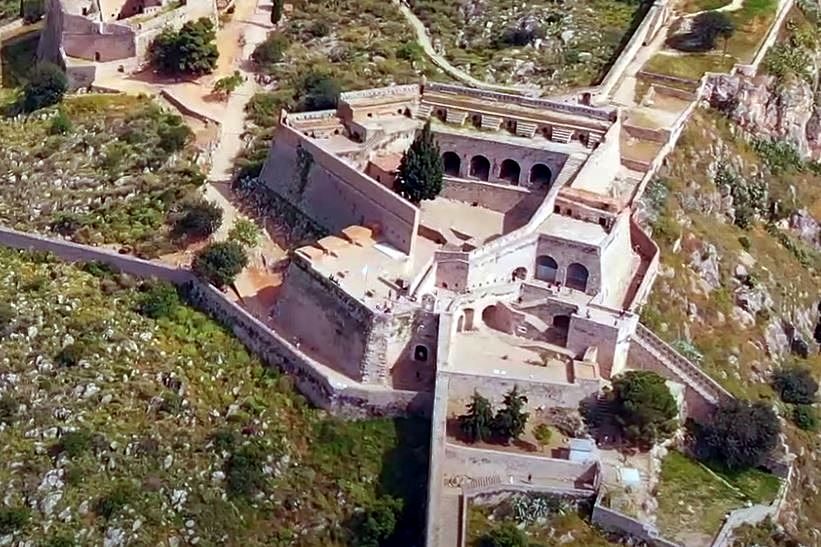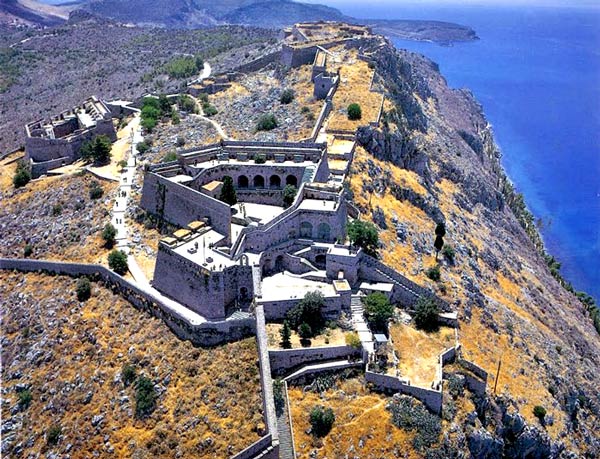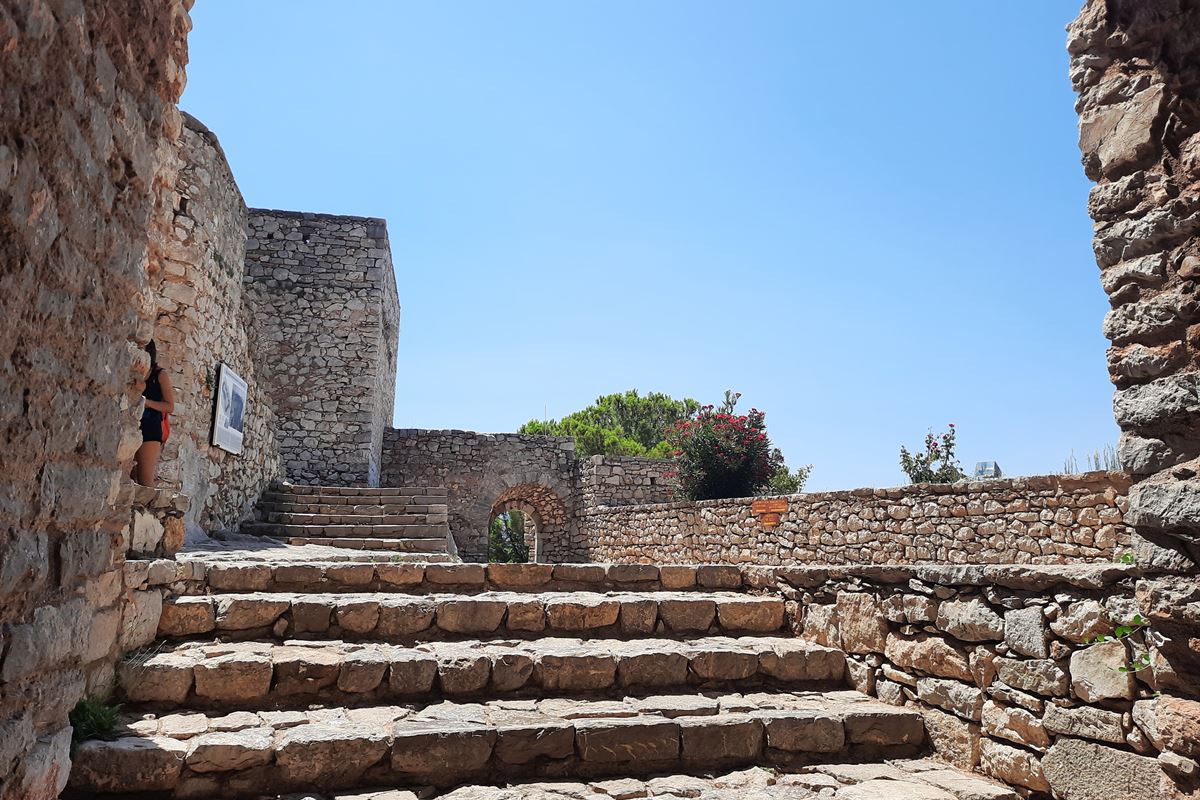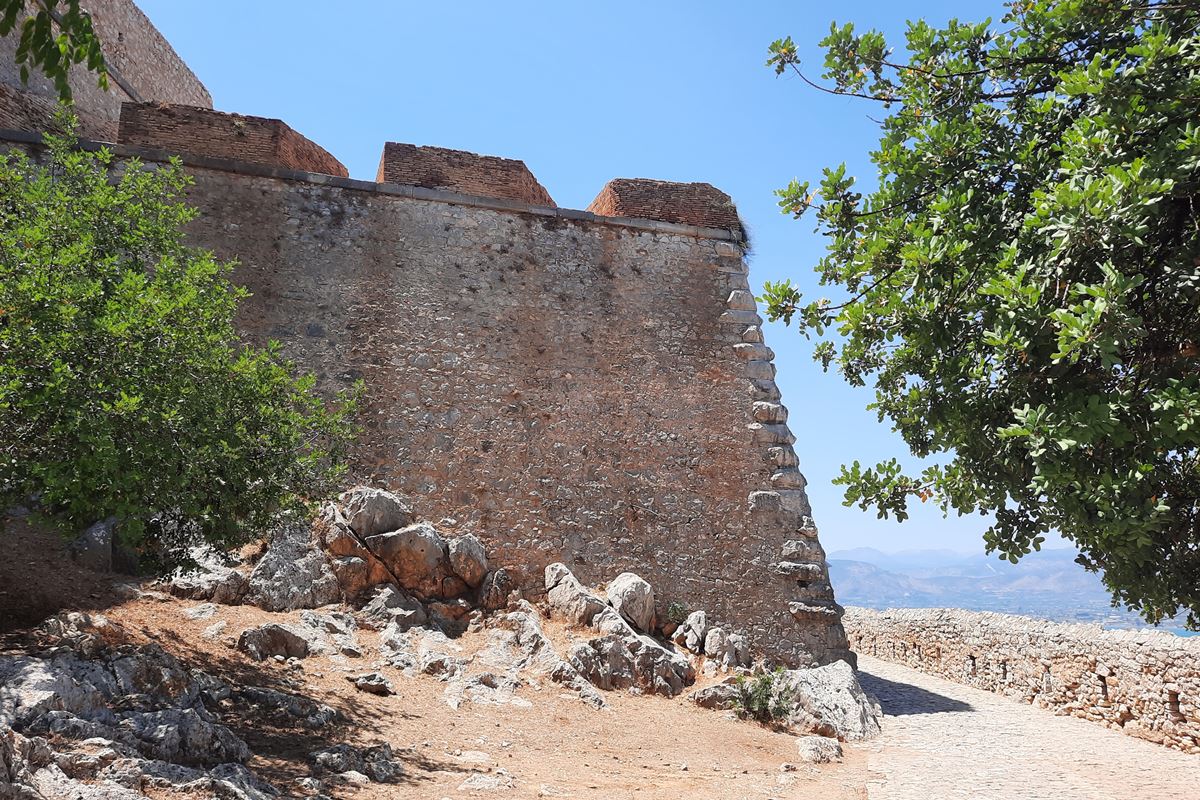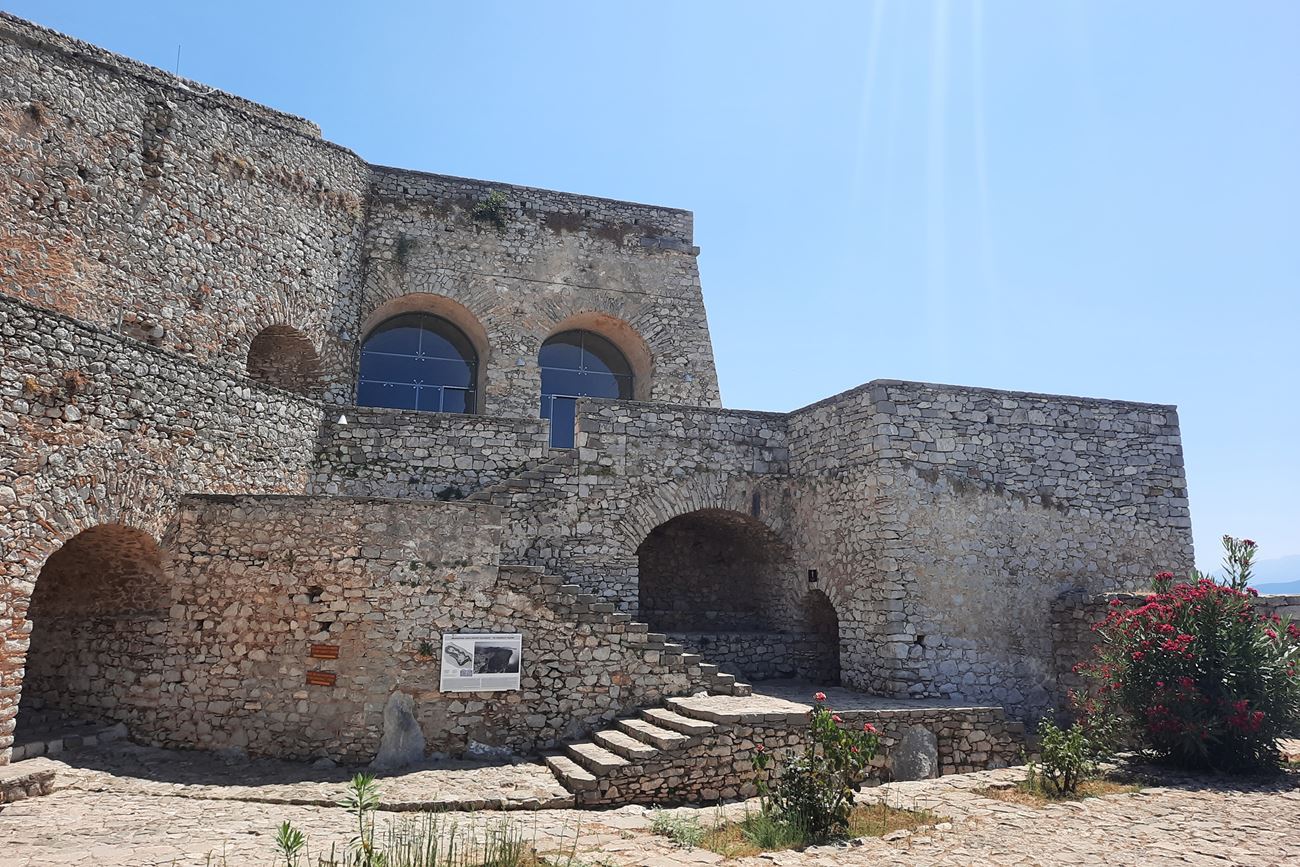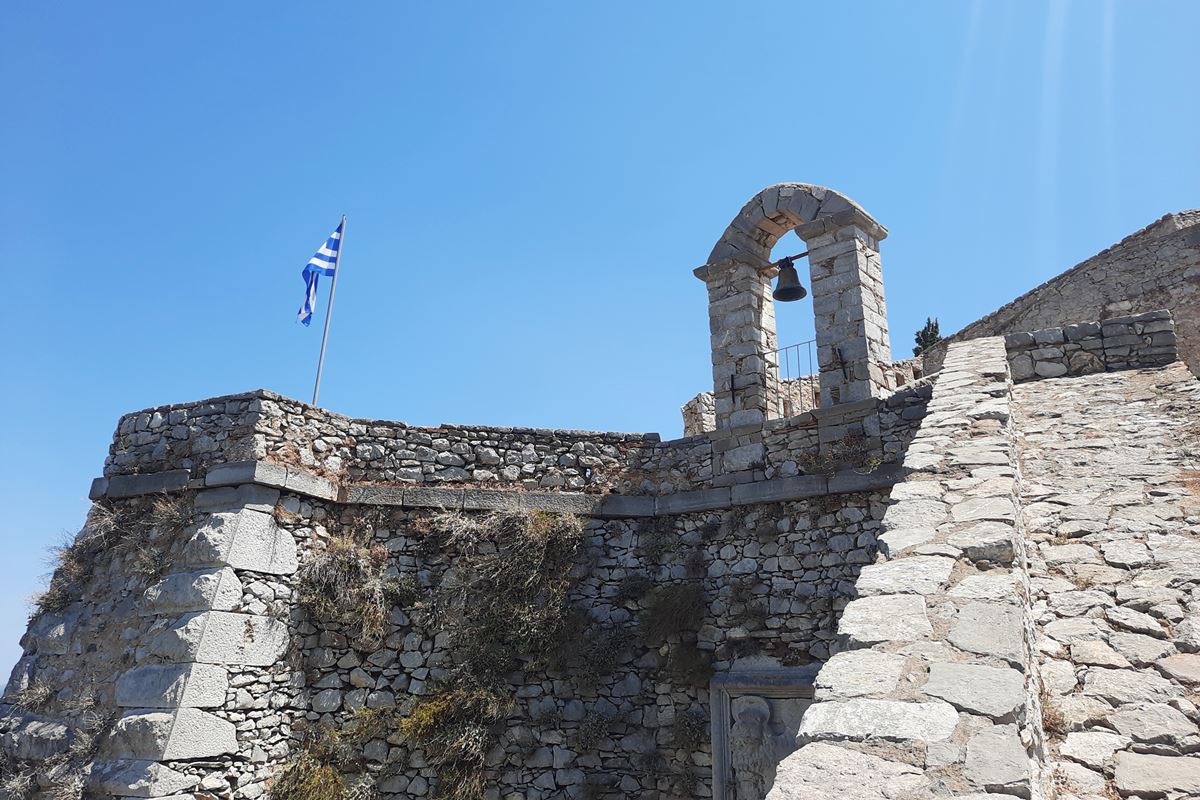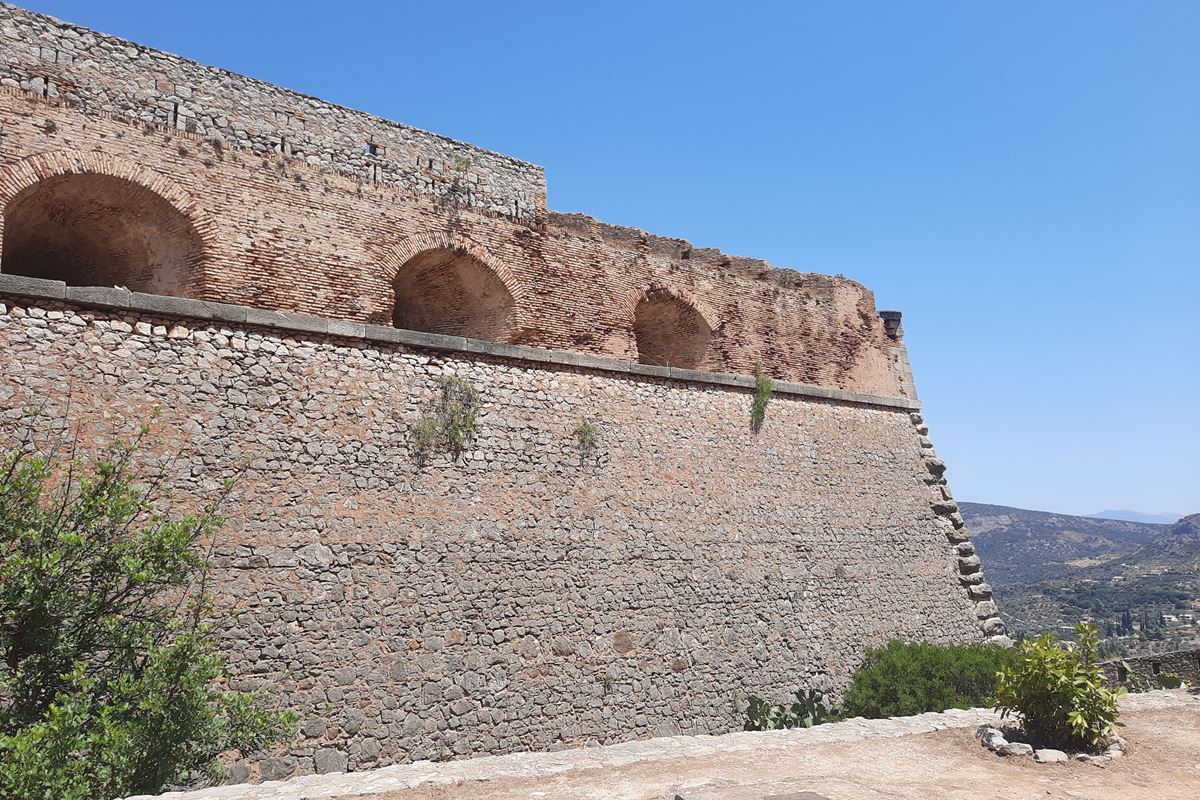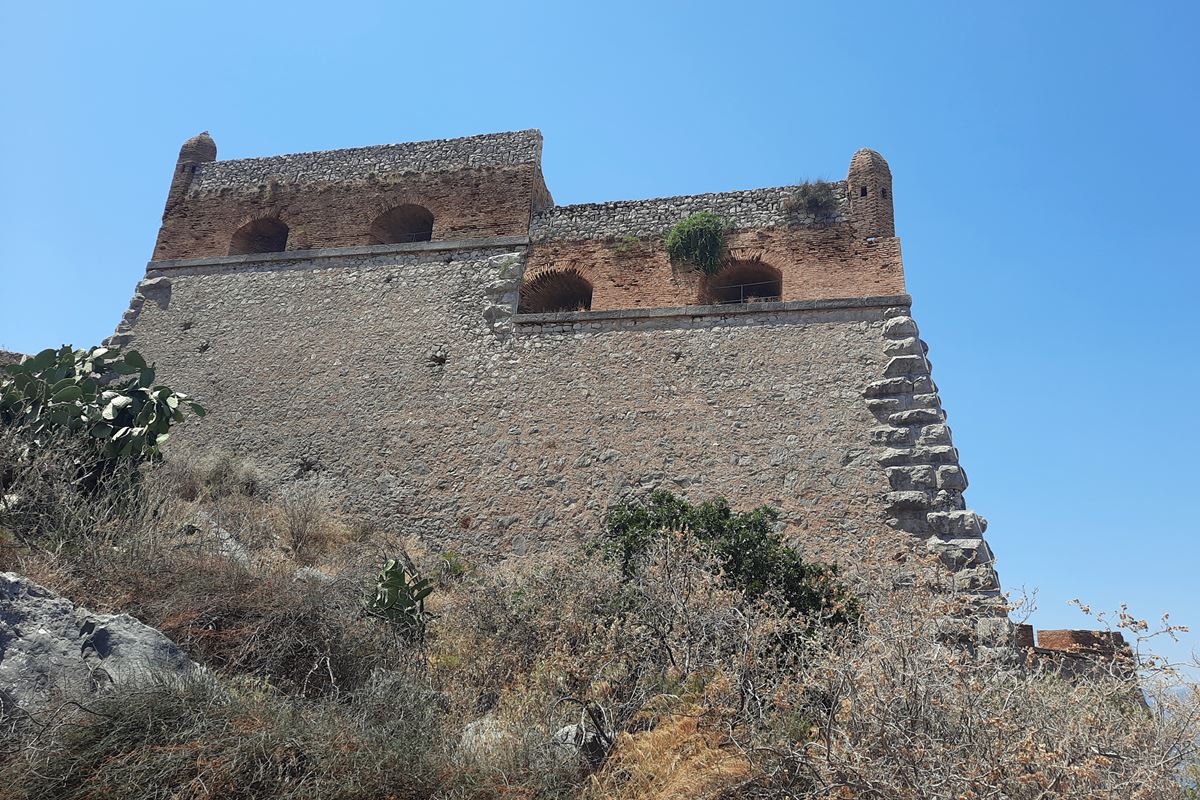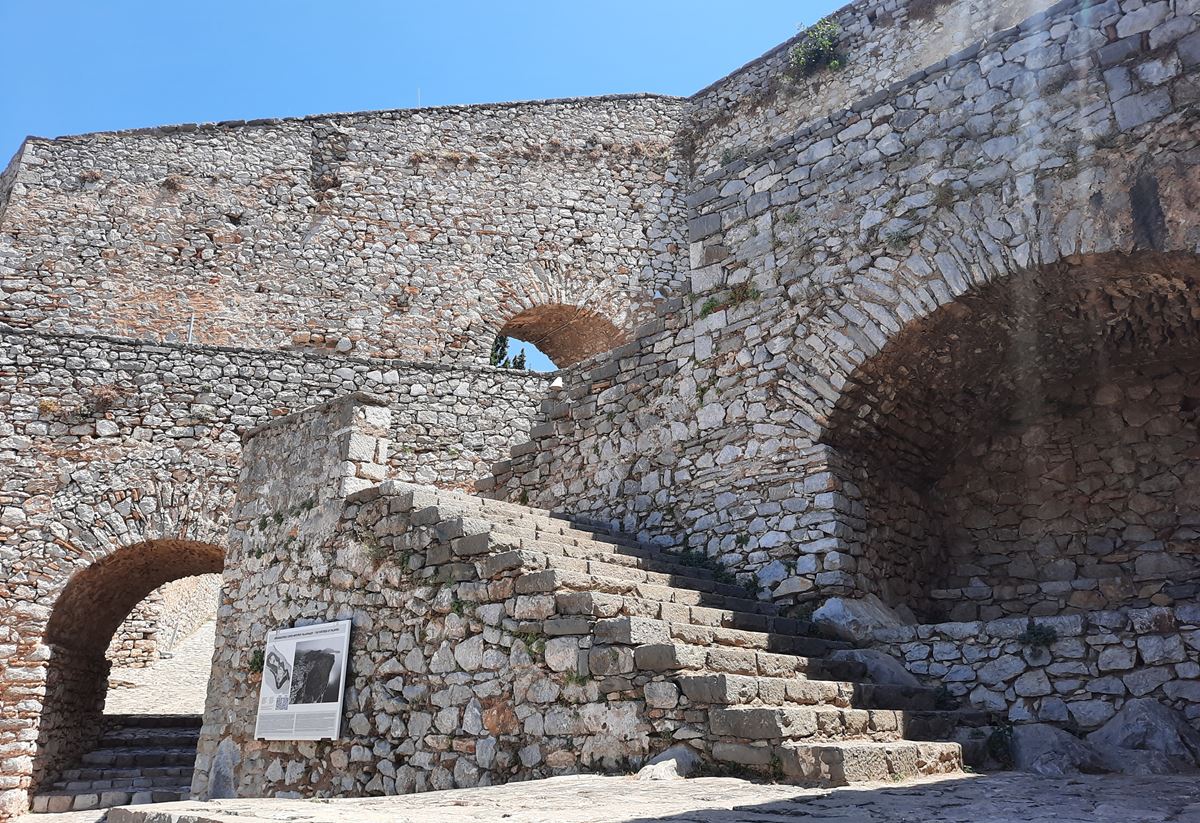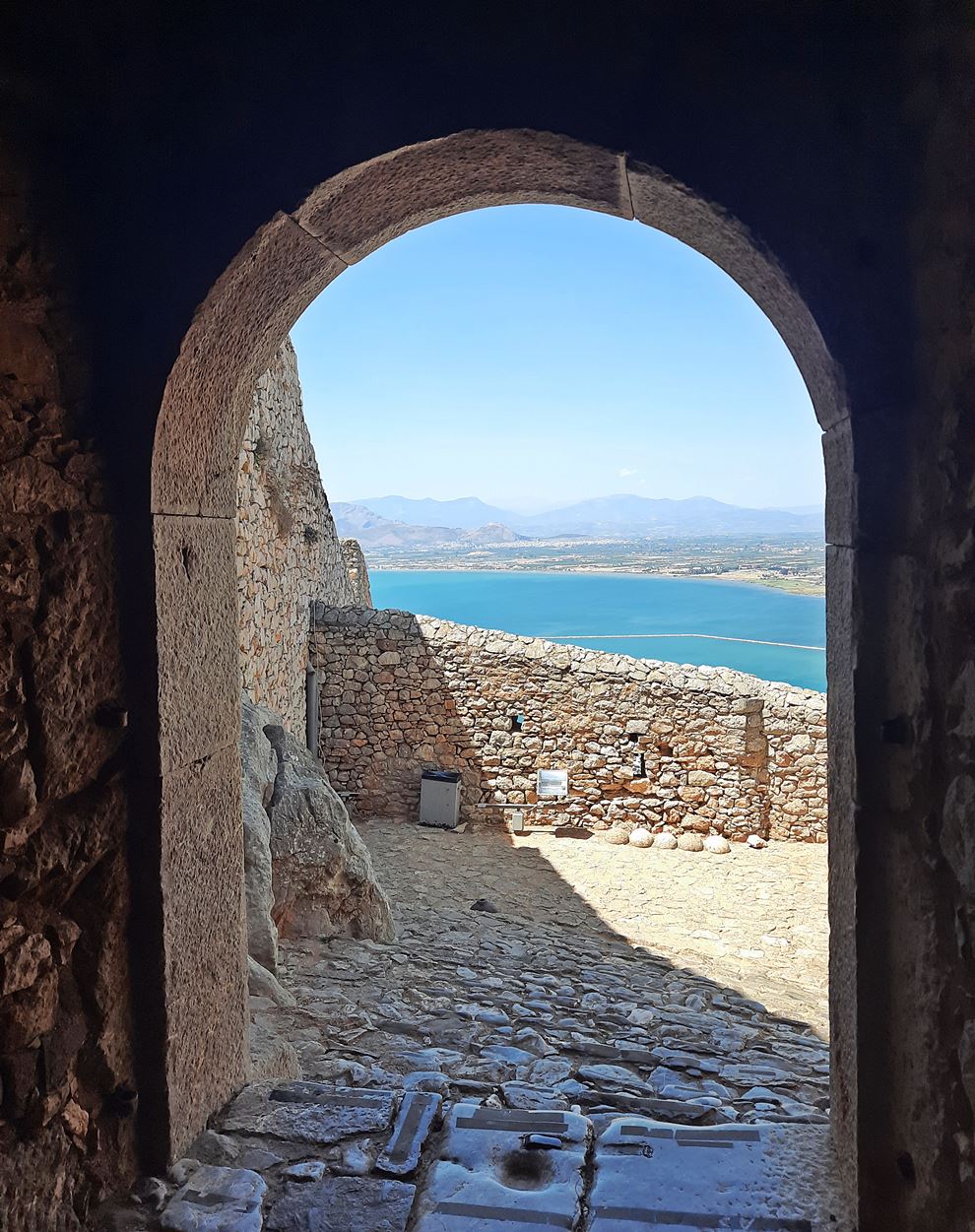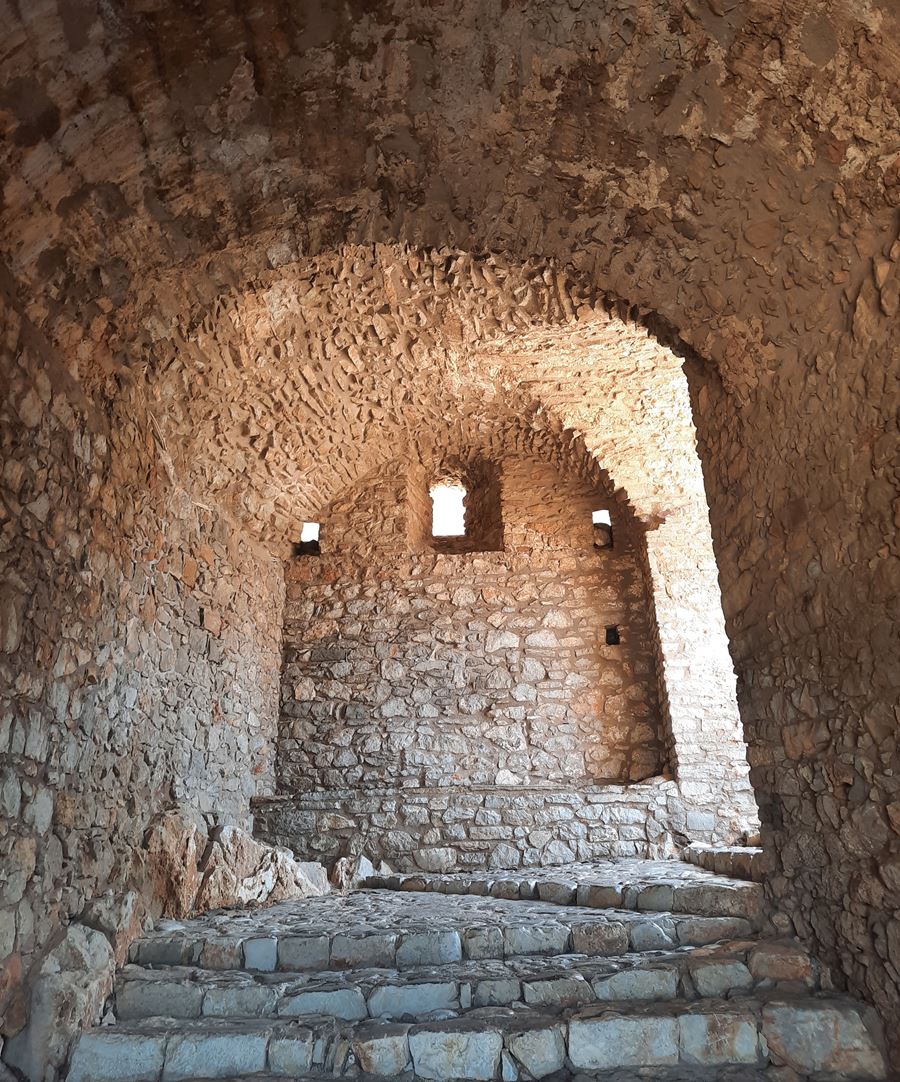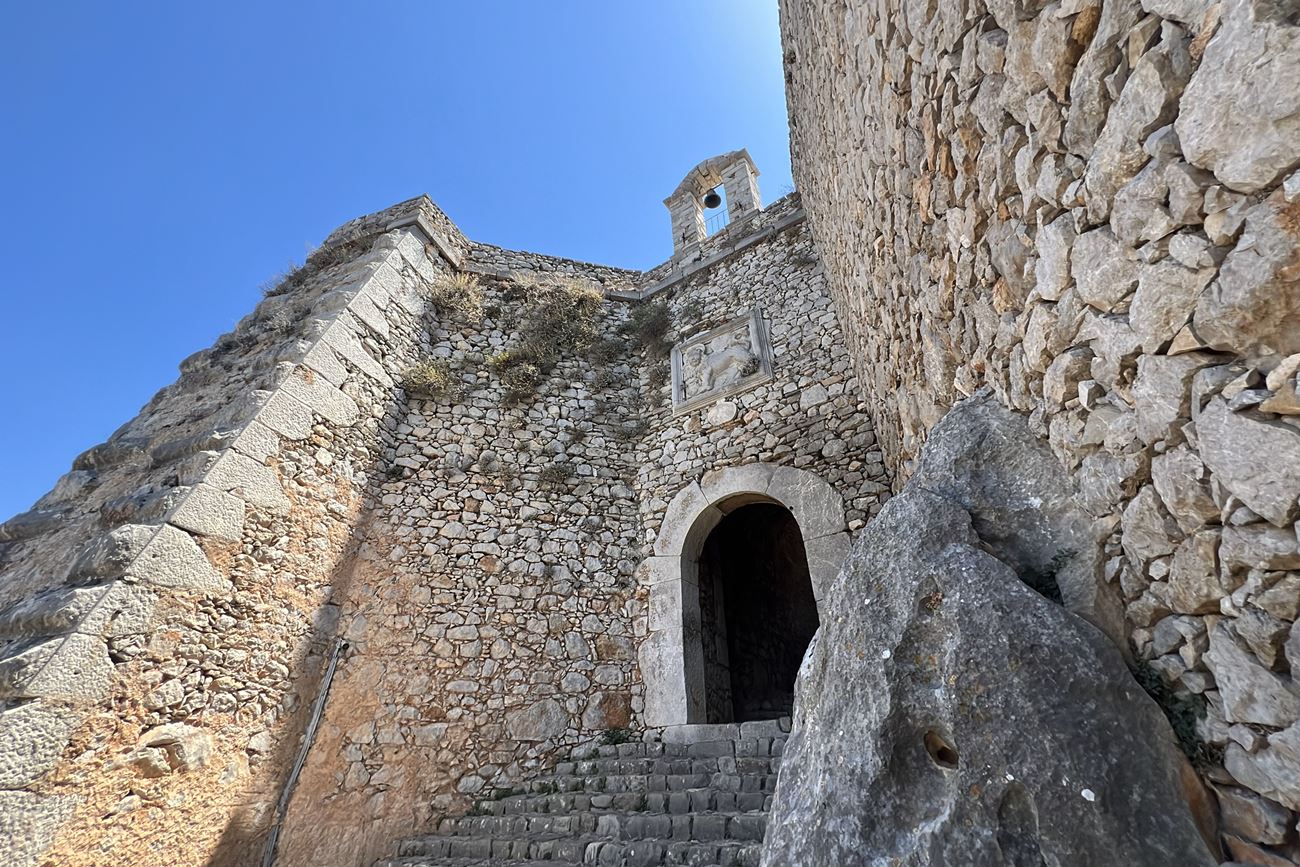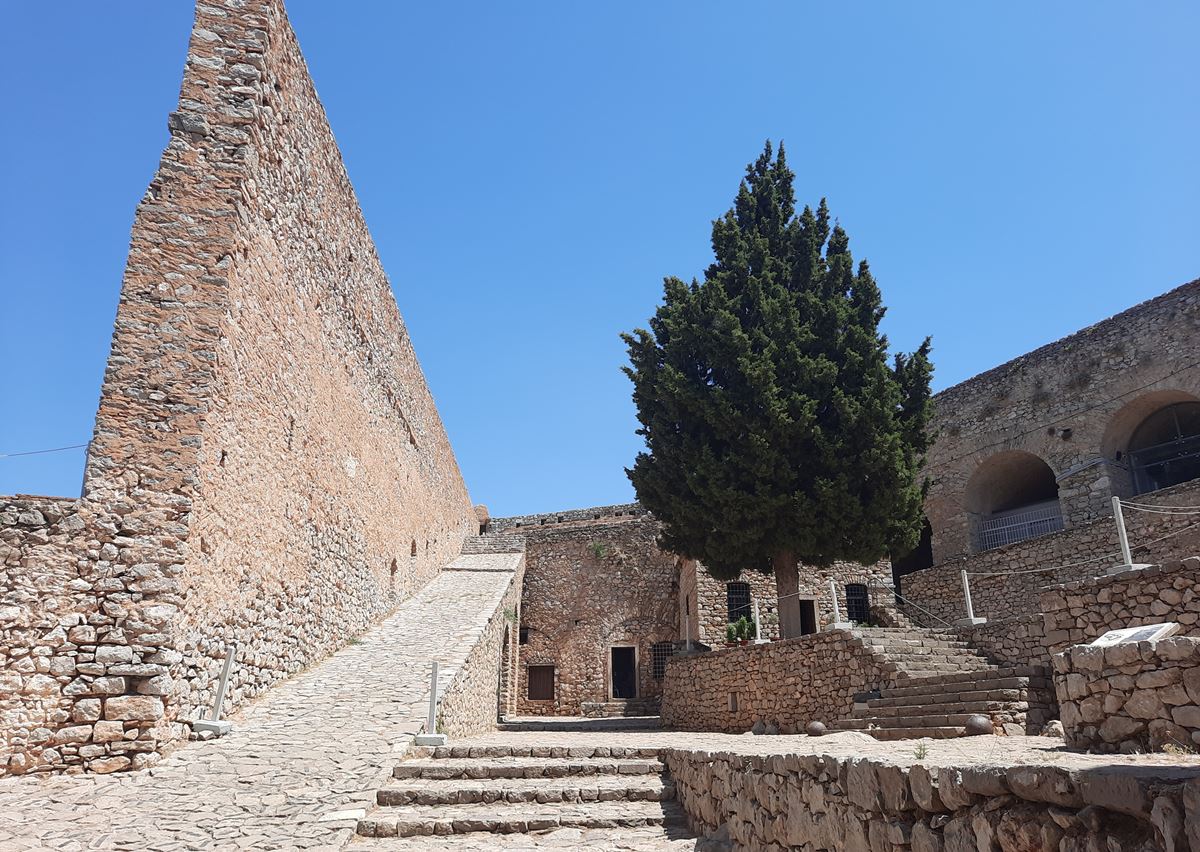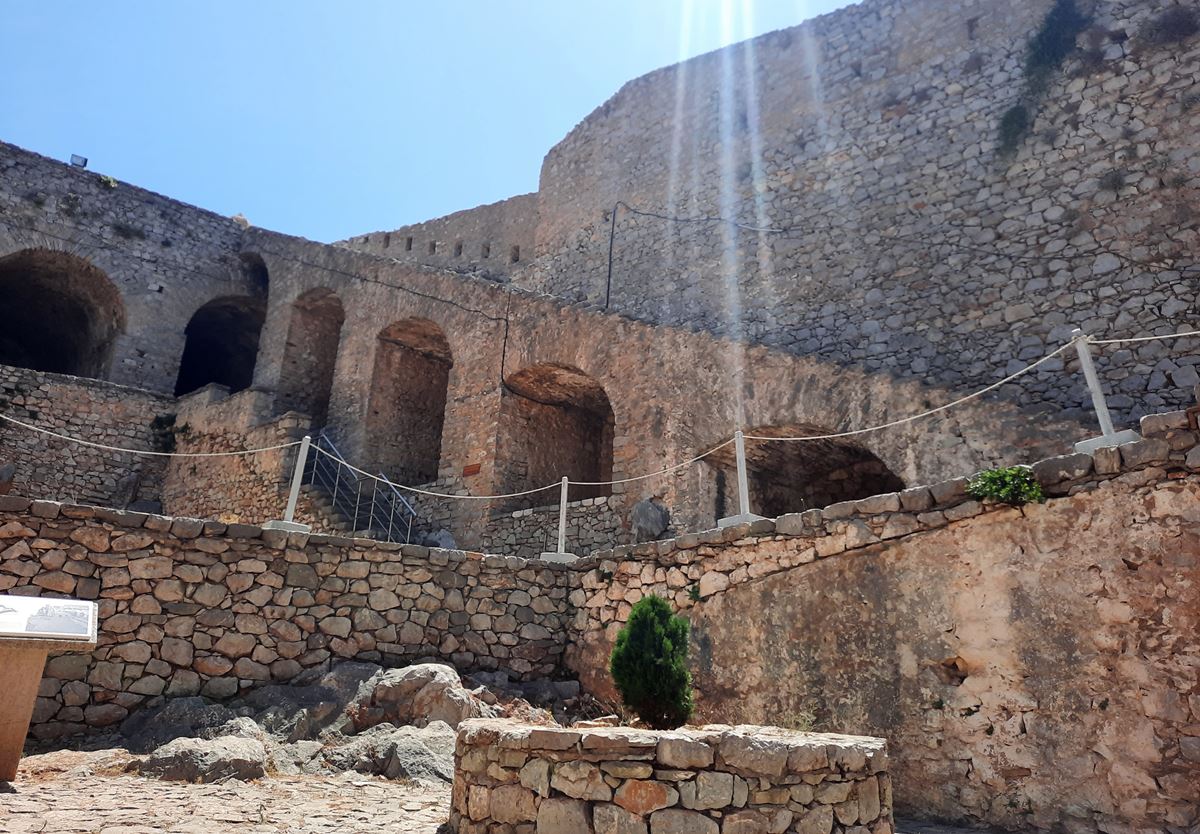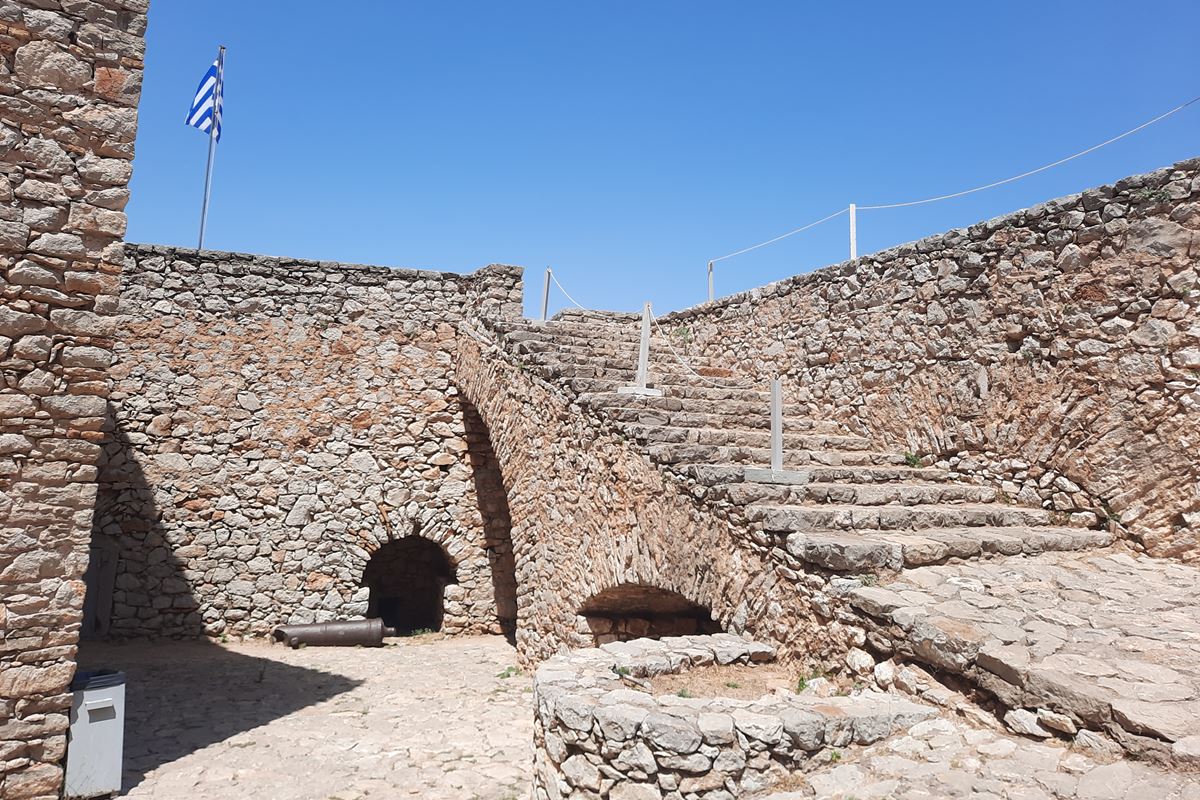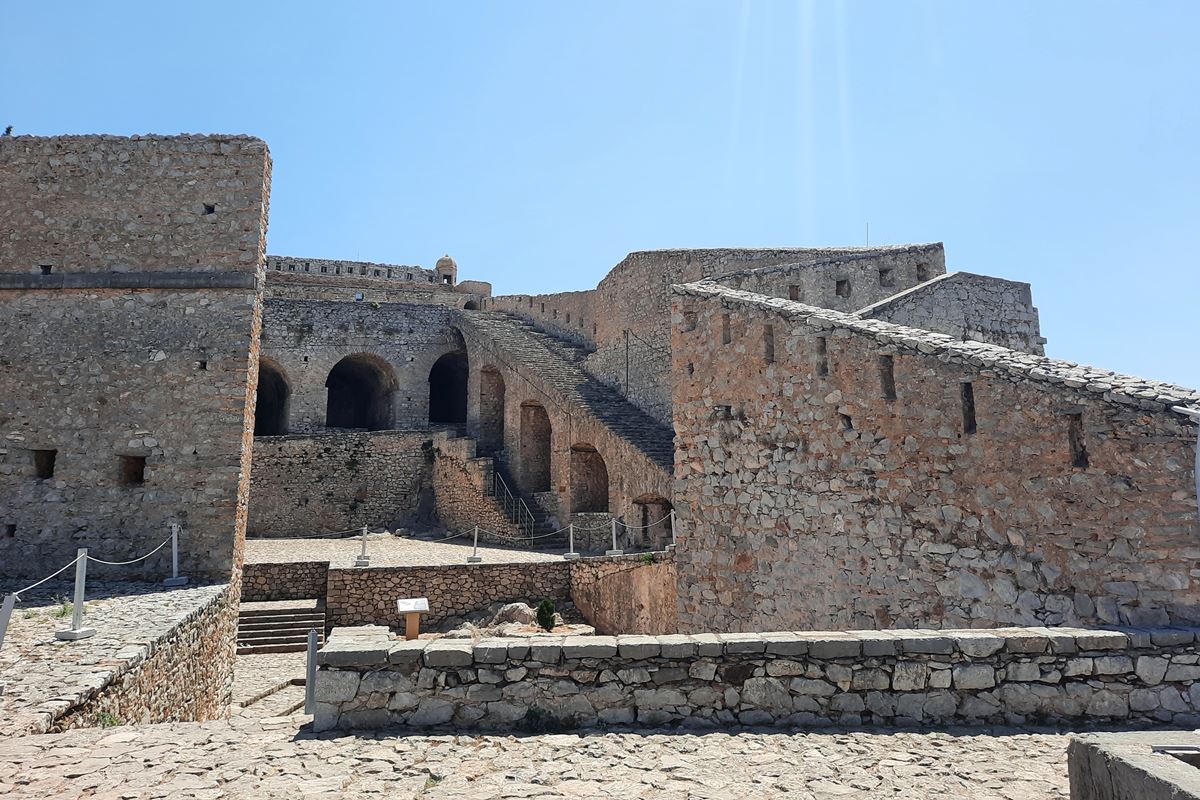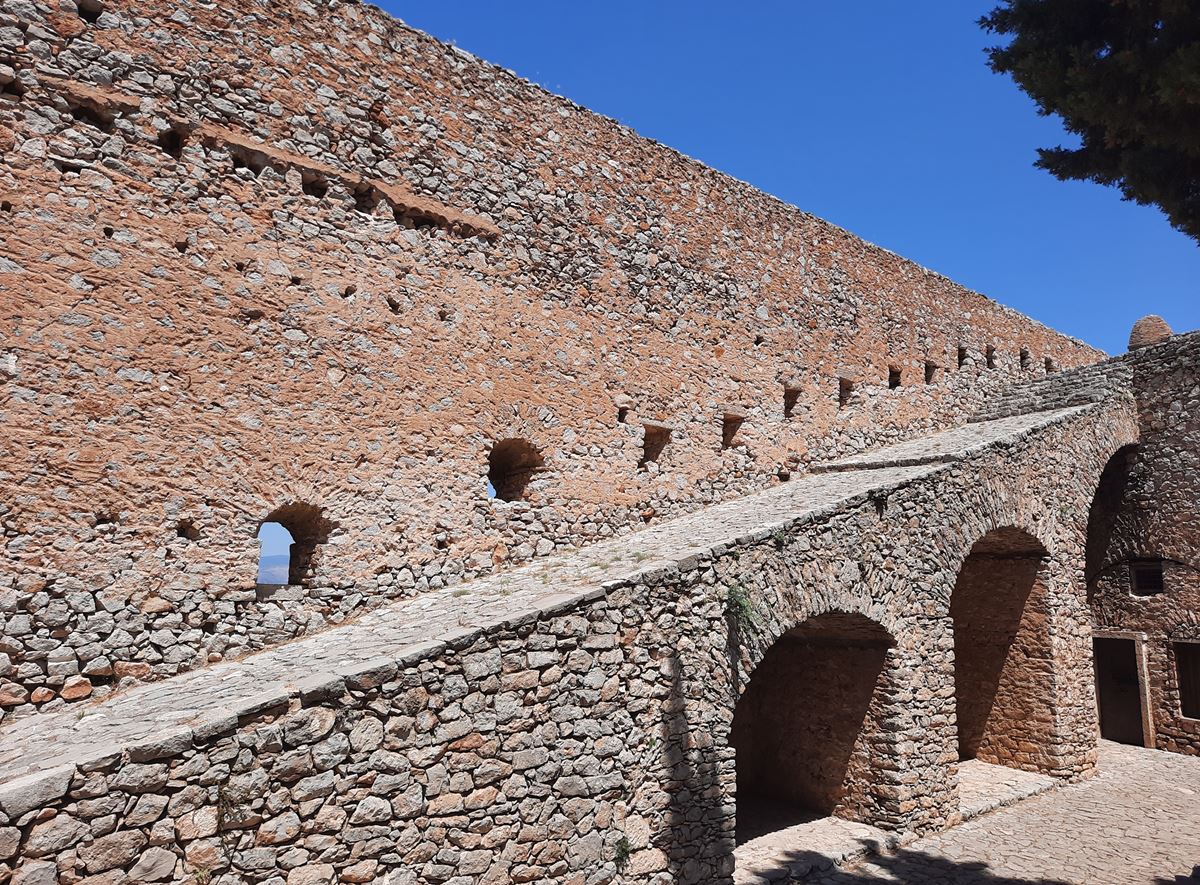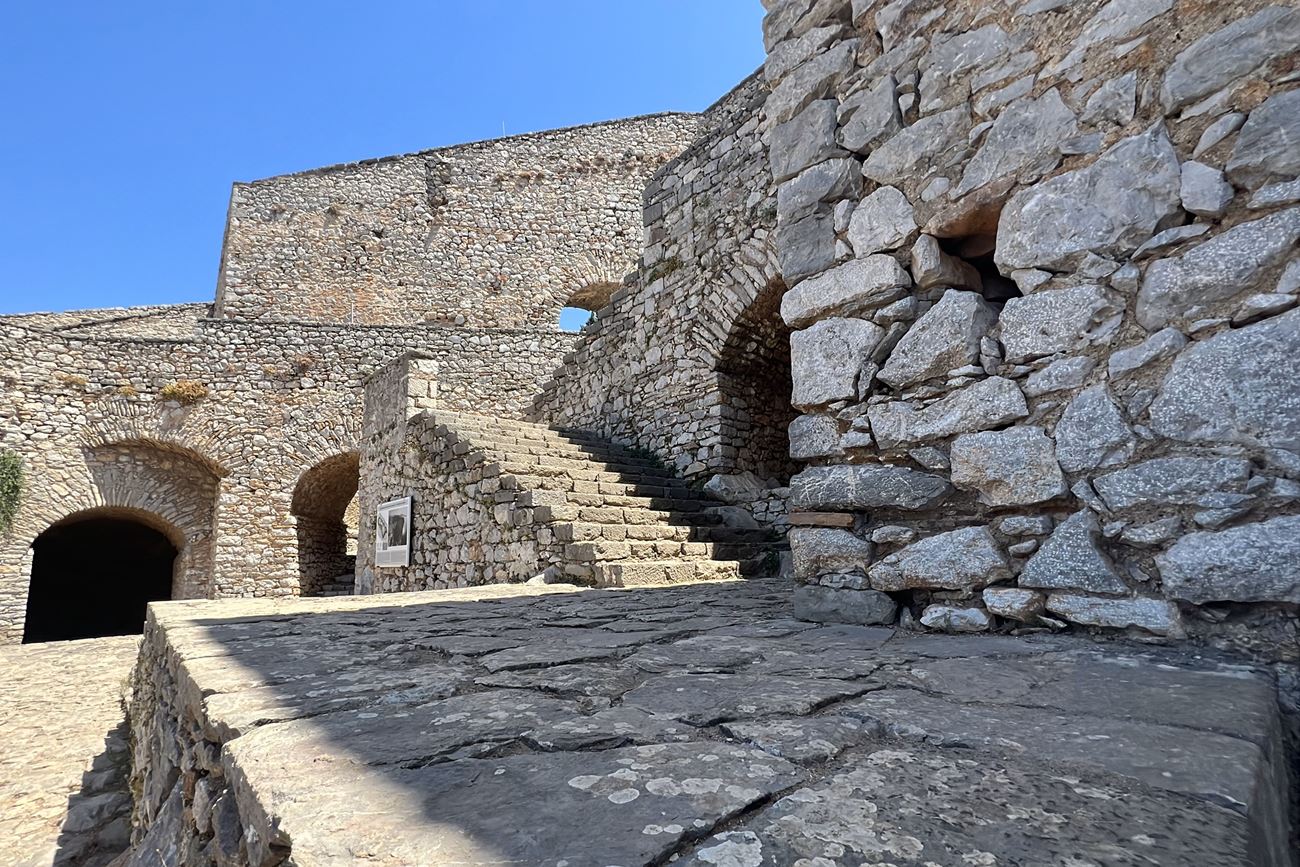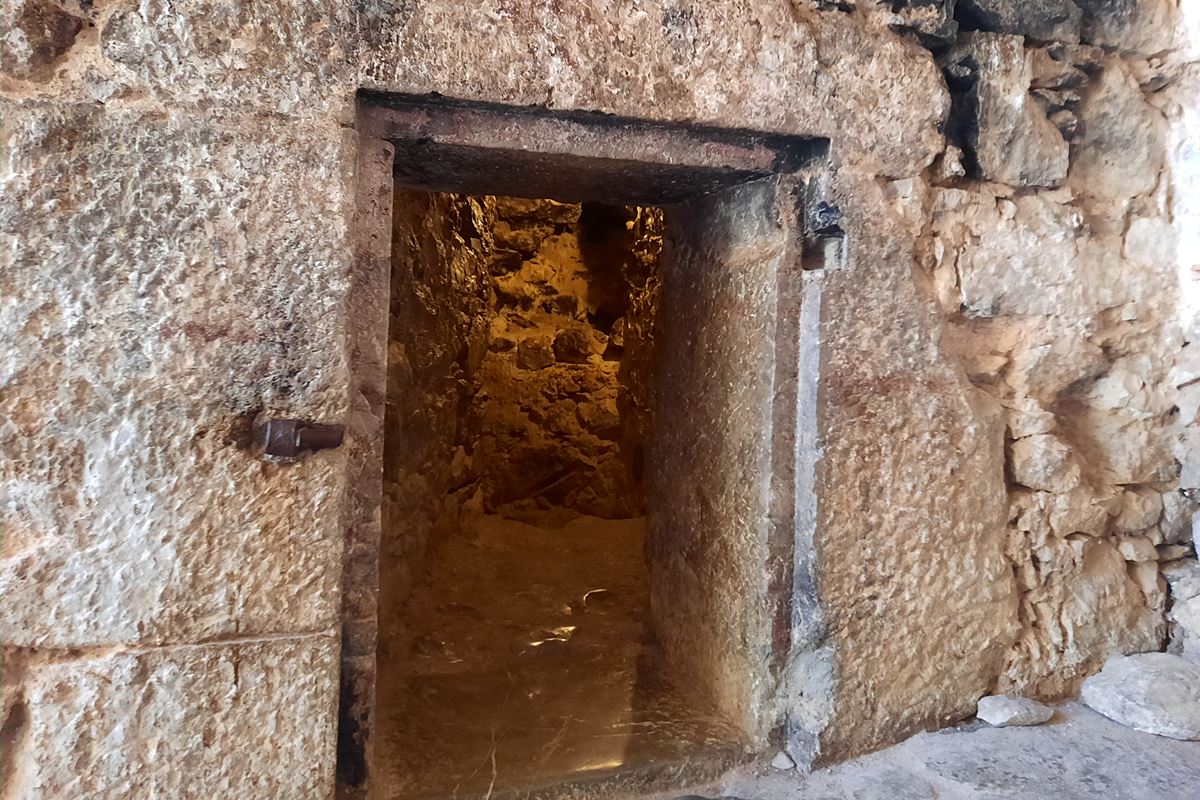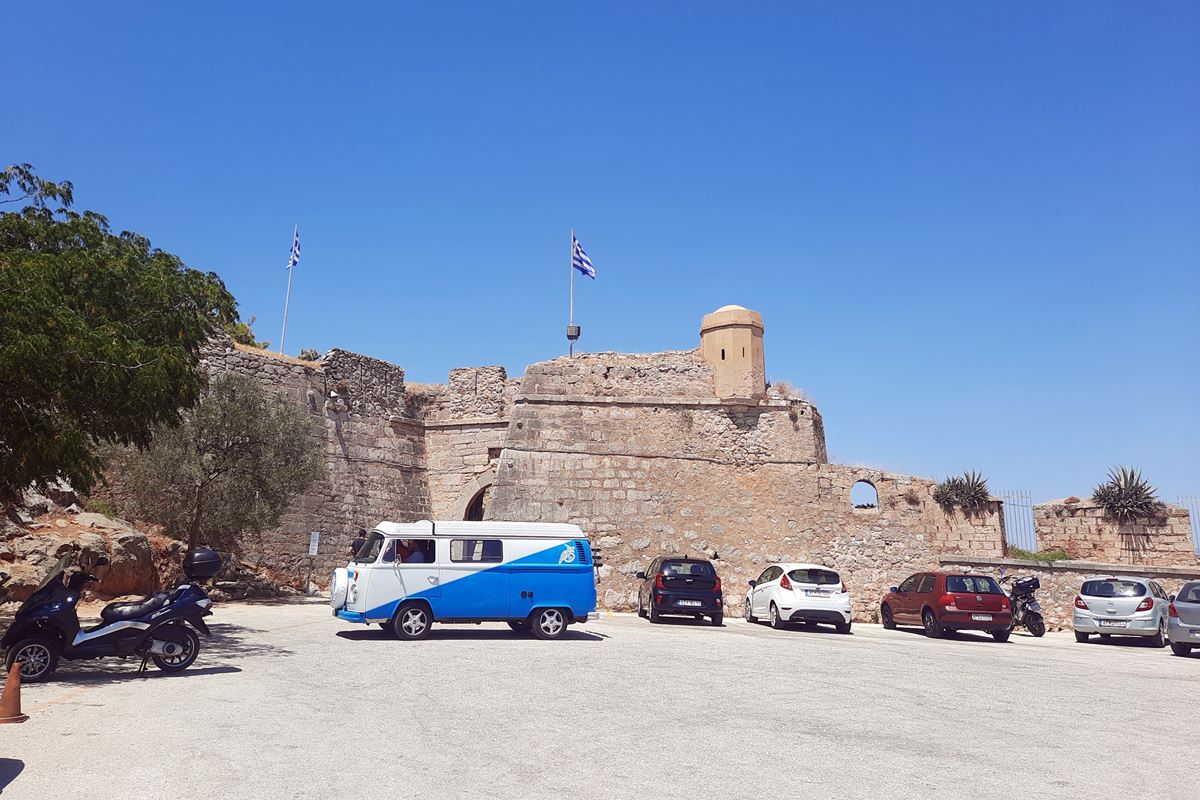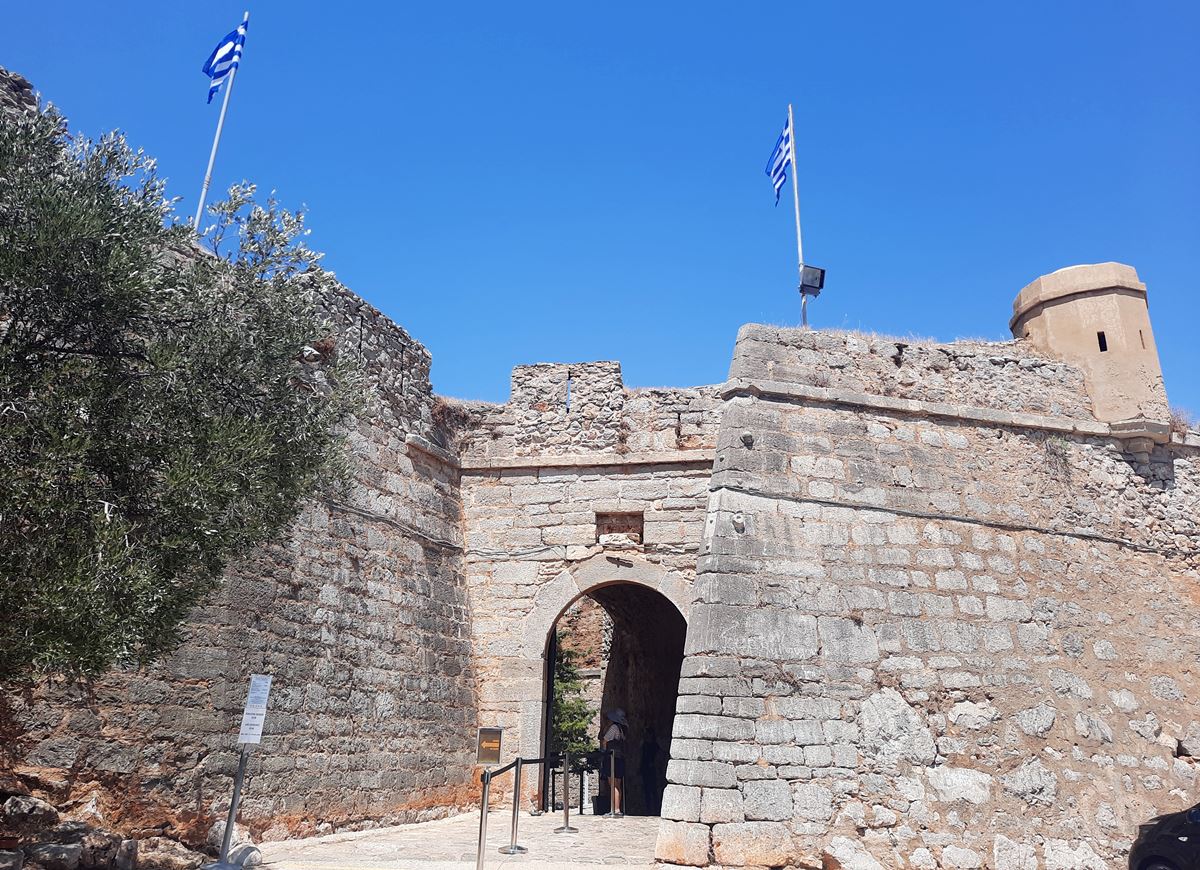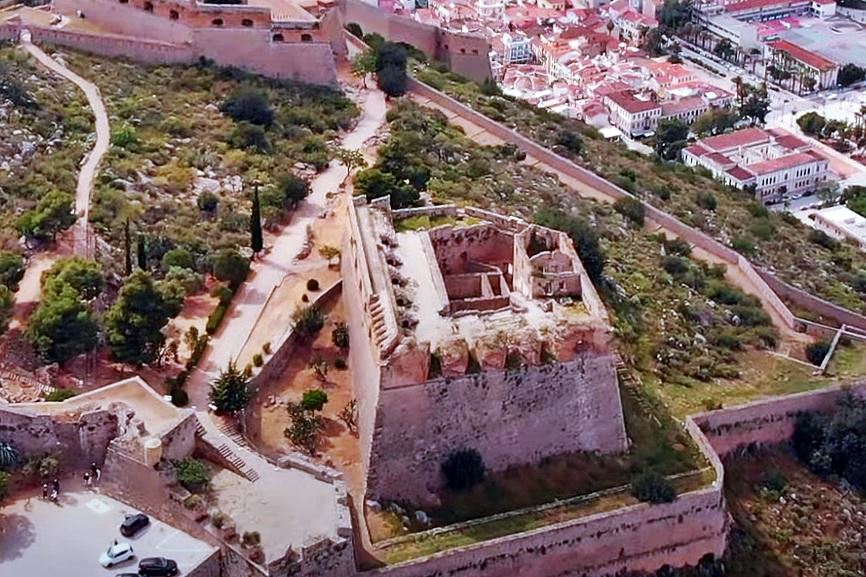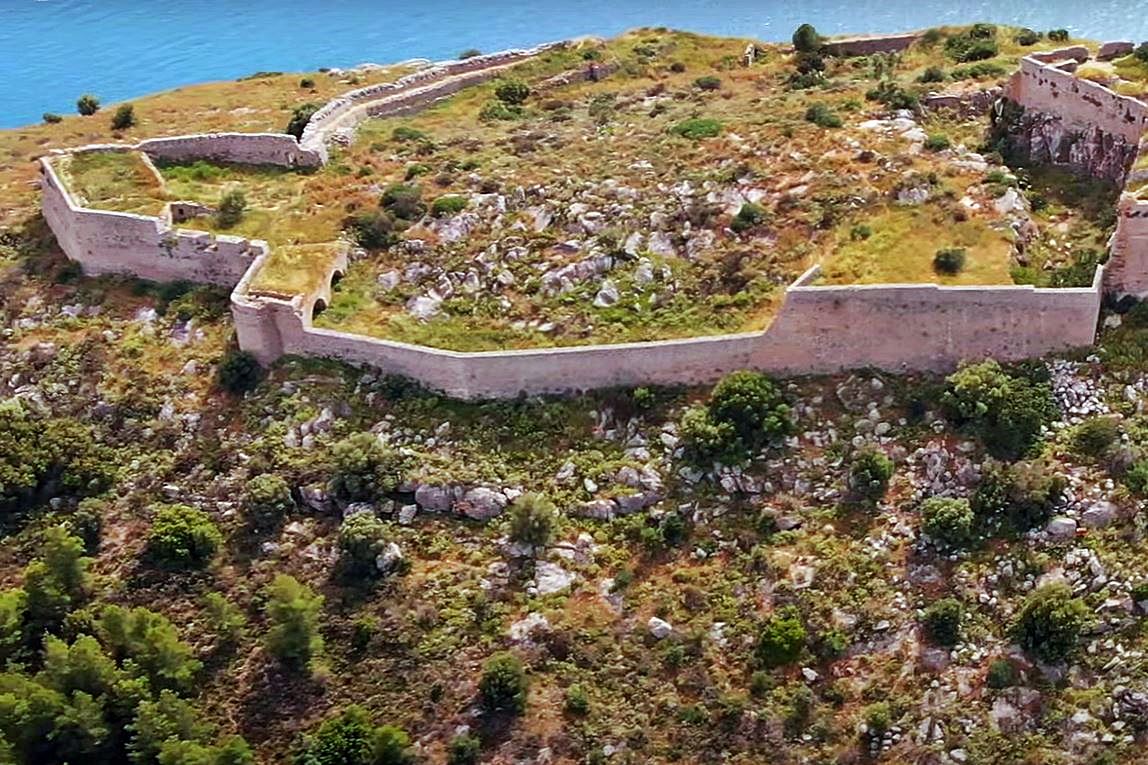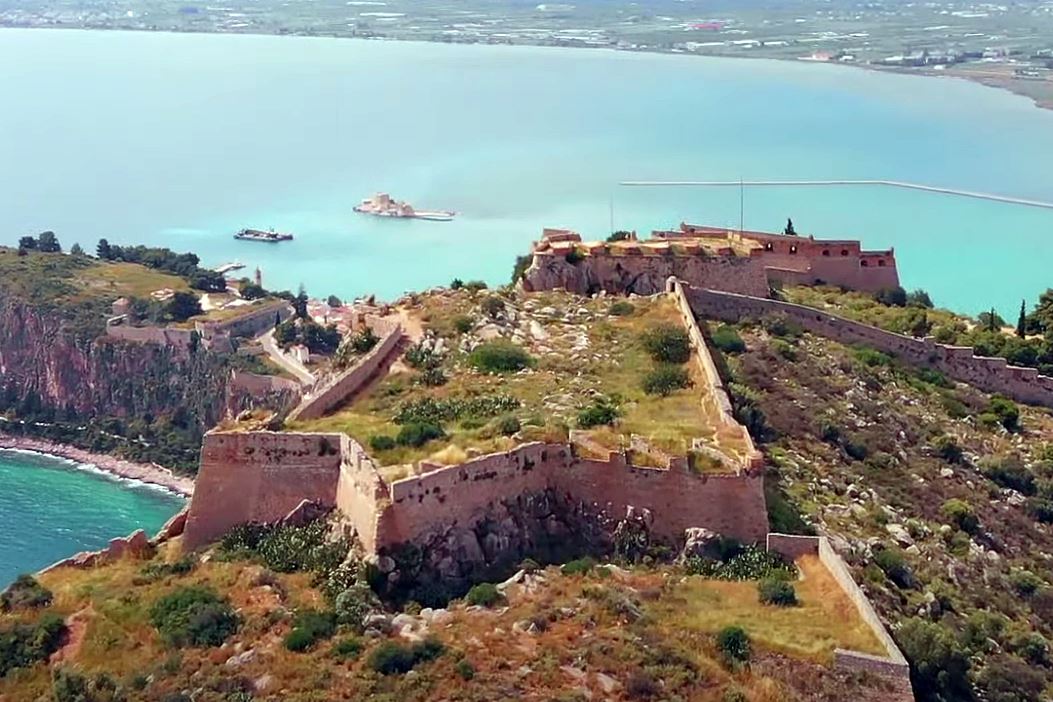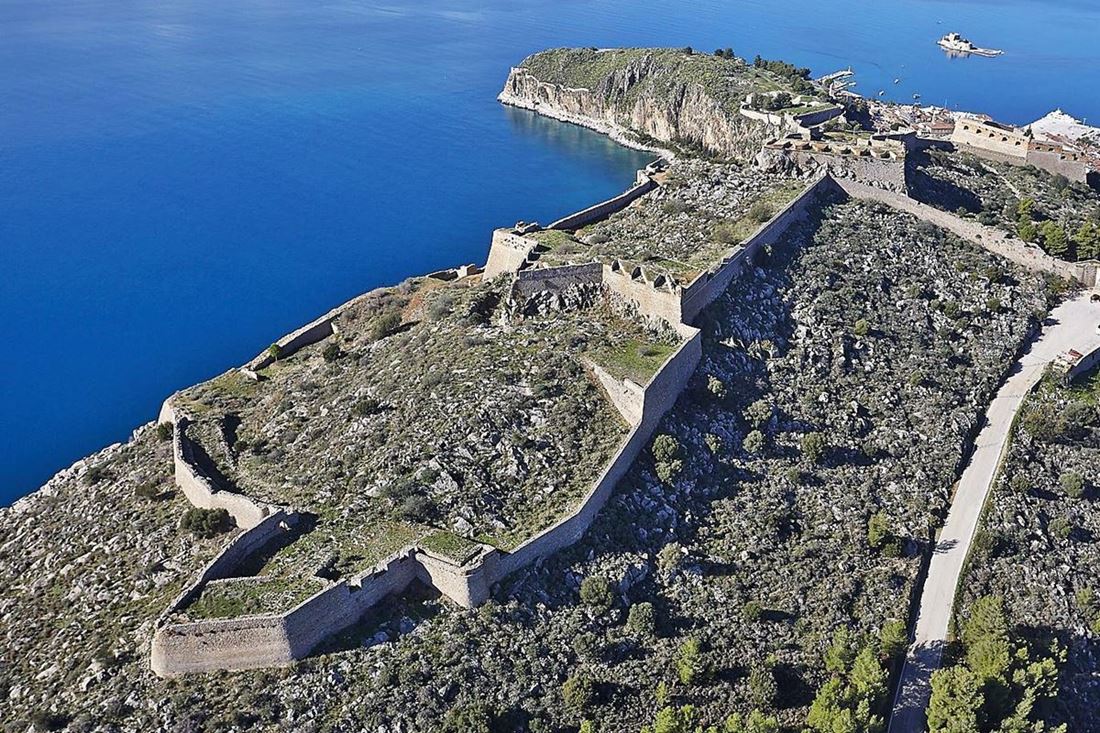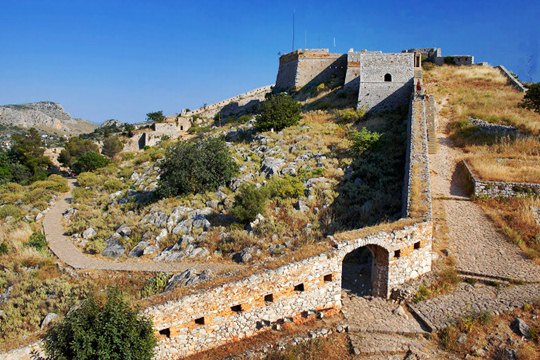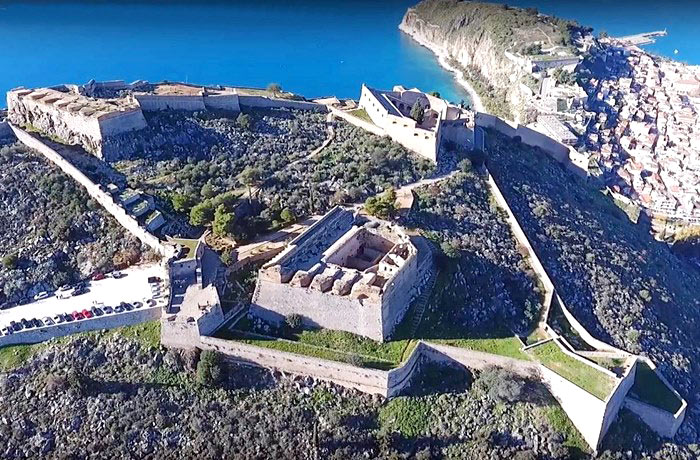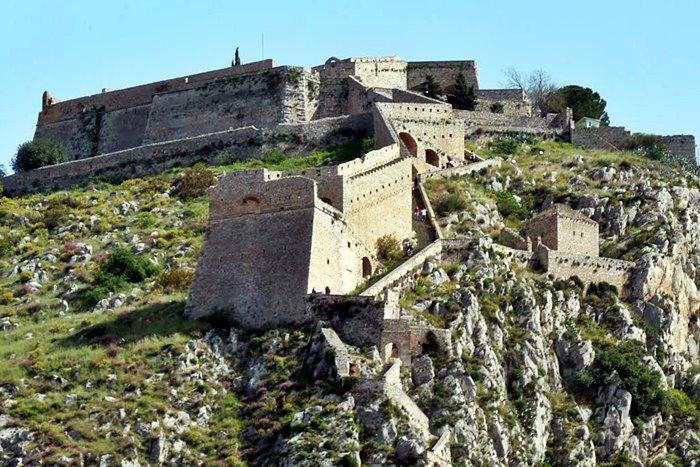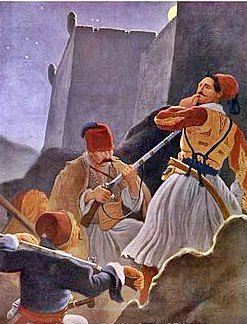Nafplio, Nafplion, Argolis,Peloponnese
Palamidi
| Location: |
| Palamidi hill above Nafplion, Peloponnese |
| Region > Prefecture: | 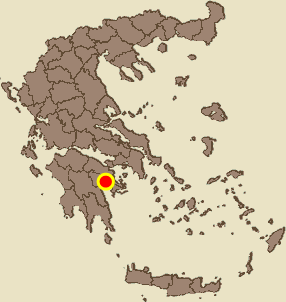 |
| Peloponnese Argolis | |
| Municipality > Town: | |
| City of Nafplion • Nafplio | |
| Altitude: | |
|
Elevation ≈ 216 m (Relative Height≈216 m) |
| Time of Construction | Origin | |
| 1714 | VENETIAN |
|
| Castle Type | Condition | |
| Fortress |
Good
|
Palamidi (Greek: Παλαμήδι) is a huge, well-maintained and probably the best castle in Greece and the finest sample of the Venetian fortifications in Greece.
It was built in 1714 by the Venetians, within the record time of 3 years during their second occupation of the area (1686-1715).
Location & Strategic Scope
Palamidi is to the east of the Acronafplia in the town of Nafplio in the Peloponnese region of southern Greece. It is built on a a 216-meter high hill with the same name.
The strategic advantages of the location are obvious: it controls the city of Nafplion, the port, the fortress of Acronafplia and the entrance to the gulf of Argolis.
History
The fortress was a big and ambitious project, but was finished within a relatively short period from 1711 until 1714 during the rule of the provedittore Agostino Sagredo. The works were started by Morosini the conqueror of the city and were carried on till the last years of the Venetian occupation (1686 - 1715). It is a typical baroque fortress based on the plans of the engineers Giaxich and Lasalle. In 1715 it was captured by the Turks and remained under their control until 1822, when it was captured by the Greeks.
Palamidi was besieged the very first year of the Greek Revolution (1821). The leaders made the right speculation that its possesion would offer the Revolution a bulwark and a proper seat for the Government. After many efforts and failures, on the night of November 29th 1822, Staikos Staikopoulos with Moschonissiotis and 350 select soldiers managed to set foot οη Achilles's bastion and subsequently occupy Palamidi. After a while Kolokotronis arrived and made Nauplion's guard surrender and sign a treaty. Every year οη the 30th of November the anniversary of the liberation of the city is celebrated at Nauplion.
Structure, Fortification & Buildings
The castle was designed by the engineer Giaxich and built by the French engineer LaSalle.
The Bastions
The design of the Fortress is based on a system of mutually supporting bastions, which are developed in stages on the West-East axis and are connected to each other by walls. The castle’s eight bastions in total are autonomous, so that if one of them is captured, the defense is continued by the others.
The 8 bastions are as follows (note that the names of the bastions changed according to the occupiers of the fortress):
• Agios Andreas (Ven: San Girardrdo, Turkish: Dişdar tapia) — photo 6, 7, 8-26
Here was the command center. It was the best fortified bastion. At the back of the central courtyard is the chapel of Agios Andreas, originally dedicated to Agios Gerardos, patron saint of the Sagredo family. During the Greek Revolution, Palamidi was captured on St. Andrew's Day, and the Greeks dedicated the old ruined Venetian chapel to his memory.
The entrance to the bastion is through an imposing gate to the north (photo 17) where the stone staircase leading from Nafplion leads. Above the gate is a built-in relief with the symbol of Venice, the Lion of Mark the Evangelist, with an inscription praising the founder Sagredo.
• Epaminondas (Turkish: Seitan tapia) — photo 25, 26, 27, 32
A low bastion, the construction of which was started by the Venetians but completed by the Ottomans who called it “Seitan tapia” (=devil’s bastion) because it might have been vulnerable to enemy attacks.
In front of this bastion is the current car parking and here the eastern (and main) gate of the fortress is located (photo 26).
• Miltiades (Ven: Baloardo Staccato, Turkish: Bazirgan tapia) — photo 27, 32
It had access only from the west side where a cobblestone road leads that starts east from the bastion of Agios Andreas. On its south and east side there was a moat. It was the main point of defense against attacks from the east.
It was used as a prison in the 19th century.
• Leonidas (Ven: Piatta Forma, Turkish: Kur tapia) — photo 32
Small bastion north of the Miltiades bastion, at the easternmost point of the castle. Access is from Miltiades or Epaminondas bastions. Its purpose was to protect Nafplio (the city, not so much the fortress) with its cannons against land attacks.
• Robert (Ven: Mascio, Turkish: Deniz kapi) — photo 33
Small bastion that looks more like a single tower. Its purpose was to control access from the city, before the bastion of Agios Andreas, where it was the main entrance of the Venetian layout. The Turkish name means sea gate.
The Robert bastion was named in honor of the French philhellene Francis Robert who was killed in 1826 in the siege of the Acropolis of Athens.
• Themistocles (Ven: Posto di San Agostino, Turkish: Kara tapia) — photo 29, 30
A large bastion that is separated by a large moat from the Phocion bastion (which is located lower). It is also separated by a moat from the Achilles rampart which is a little higher and from which it is also separated by a wall.
• Achilles (Ven: Doppia Tegnalia, Turkish: Yuruis tapia) — photo 28, 30
The Venetian name means bastion of repulsion or crash but, historically, it proved to be the weak point of the fortress, even though it is located on the highest point of the rock of Palamidi. In 1715, the Turks captured Palamidi by storming this bastion, which is why they called it “youruis”. From the same point, the Greeks under Staikopoulos also entered Palamidi on the night of November 29, 1822.
• Phocion (En: Mezzo Bastione, Turkish: Tavil dapia)
It is located south of and above the central bastion of Agios Andreas. It is the only bastion built entirely by the Ottomans. It protects the access to the bastions of Themistocles and Achilles that are located above. It also monitors the sea in the area above the current Arvanitia beach, and is the second line of defense to the east, after the Epaminondas and Miltiades bastions.
The staircase
An uphill staircase reinforced in parts with low crenellations leads to the Palamidi Fortress starting east from the Grimani bastion in Akronafplia and ending at the gate of the Agios Andreas bastion on the NW side of the fortress. According to popular tradition, it was a staircase with 1000 steps of which 999 were left because the 1000th was broken by Kolokotronis' horse.
The staircase in question was the first project built by the Venetians on the hill of Palamidi. Its construction began in 1690. Initially it was vaulted (i.e. it was something like a tunnel) and at intervals it had openings in the roof for ventilation. Today, a large part of it is preserved, but it is not accessible.
The staircase that survives today was built later, and perhaps in some places coincides with the original staircase. Despite what the legend says, it has fewer steps (857) and was built during the time of king Otto, in the 1840s, by convicts who were imprisoned in Palamidi, under the supervision of Bavarian soldiers.
Current Condition
The castle is impressive, well-maintained and in very good condition.
Legends & Tales
According to the legend, Palamedes set off on the expedition to Troy, but was falsely accused of being a traitor by Odysseas and executed before the fall of Troy. Palamedes' father, Nafplius, took revenge by sending his other sons to seduce the wives of the other commanders. During the long ten year siege, only one wife remained faithful to her husband (Penelope, of course).
| First entry in Kastrologos: | July 2012 | Last update of info and text: | September 2023 | Last addition of photo/video: | August 2023 |
Sources
- Website Δήμος Ναυπλιέων
- Video by the user Άγγελος Αρναουτέλης titled Παλαμήδι ΑΝΩΘΕΝ - Aerial video by drone Dji Phantom 4
- Video by the user Kostas Gertzos ΚΑΣΤΡΟ ΠΑΛΑΜΗΔΙ, ΝΑΥΠΛΙΟ (DRONE). PALAMIDI CASTLE, NAFPLIO, GREECE.
- Photos 4, 8-26 by Ismini Papathanasiou (August 2023)
|
|
| Access |
|---|
| Approach to the monument: |
| A road leads to the top of the hill. Alternatively there are 857 stairs from Nafplio… |
| Entrance: |
| Ticket entrance. Limited hours. |
| Timeline |
|---|
|



